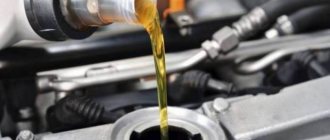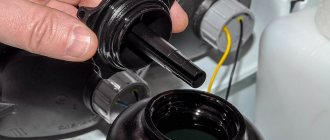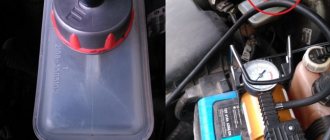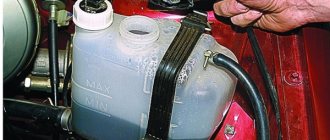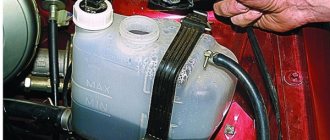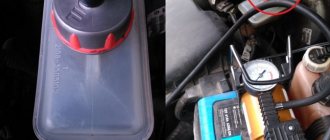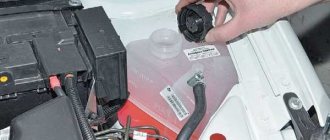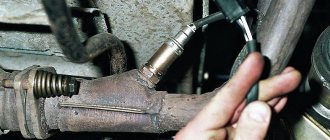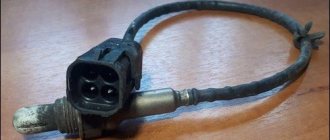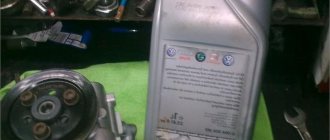In 2002, GM-AvtoVAZ began serial production of the Chevrolet Niva. This model has retained all the advantages of the old Niva - the presence of permanent all-wheel drive, a locked center differential, as well as a two-speed manual gearbox.
Chevrolet Niva has 6 trim levels, namely: L, LC, LE, GL, GLC and LE+. The last of them was presented in 2015. It differs from the rest in the presence of air conditioning, a full safety package, Continental Cross Contact tires, K&K “Camelot” wheels, special rear bumper protection, a towbar, as well as unpainted moldings.
To make driving easier, the manufacturer equipped the car with hydraulic power steering (power steering).
Let's look at what fluids are used in power steering Niva Chevrolet, how to check the oil level and replace it yourself.
Types of power steering fluids for Chevrolet Niva
The original working fluid for power steering Niva Chevrolet is Pentosin CHF 11S.
Among its analogues we can note PSF, which has almost the same characteristics, but at a more reasonable price. Pentosin is green, PSF is red or yellow.
In addition to the mentioned oils, it is worth highlighting Mannol Dexron III. This fluid is multi-purpose - it can be used not only in power steering, but also in automatic transmissions, clutches, and other similar mechanisms. Dextron has good low-temperature and antioxidant properties and an increased service life.
111–1
These are the deep grooves in the aluminum crankcase that the fluoroplastic distributor rings make. This is the case when the theory of soft interaction of materials fundamentally contradicts hard practice. These are the deep grooves in the aluminum crankcase that the fluoroplastic distributor rings make. This is the case when the theory of soft interaction of materials fundamentally contradicts hard practice.
Steering shaft corrosion makes itself felt earlier on power steering mechanisms. Due to working on a rough surface, the seals begin to wear out quickly and leak. On steering racks with electromechanical power steering, it is more difficult to recognize the onset of the disease. When it comes to noticeable malfunctions - knocking and play, corrosion will already have time to cause irreparable harm to the gear rack. In advanced cases, it affects teeth that cannot be repaired. The teeth have a complex profile and high surface hardening, and it is almost impossible to restore them correctly after any mechanical treatment.
Corrosion of the remaining surfaces of the slats is combated by three methods: grinding, grinding to the repair diameter, and backfilling. Grinding is done when the rust is superficial and the total reduction in the diameter of the rail does not exceed 0.1 mm. In this case, spare parts (oil seals and support sleeve) of nominal size are used. With such an increase in clearance there will be no leaks or knocks.
In case of deeper corrosion, it is permissible to painlessly grind down the toothed rack by no more than 0.5 mm. This is the recommendation of most manufacturers. These parts are usually hardened to a depth of about 1.5 mm. After all, they must operate reliably under oil pressures of up to 150 bar. With such a significant reduction in diameter, repair-sized spare parts are used. Oil seals are selected from catalogs, and bushings sometimes have to be made.
Frequency of power steering fluid replacement
It is believed that the oil that was filled into the power steering of a Chevrolet Niva does not require replacement throughout the entire life of the vehicle. However, if there is damage to the steering rack, various contaminants may enter the system.
Over time, the fluid forms sediment, which affects its quality; the temperature difference between winter and summer also negatively affects the condition of the oil in the power steering. This is why it needs to be replaced approximately every six years, regardless of condition.
Signs of trapezoidal problems
Even with careful driving, the trapezoid has its resource, although Chevrolet Niva owners note that it reaches 100,000 km. In fact, the information is not entirely accurate. Every 25 - 30 thousand km, it may be necessary to replace the steering tips, and they are an integral part of the trapezoid.
The first sign of a joint failure is increased play in the steering wheel. The hinge pins wear out and need to be replaced. Recently, drivers prefer to purchase rods or ends assembled with a hinge. Lack of lubrication will accelerate wear of the moving joint. Although the manufacturer adds the required amount of lubricant to the joint, compliance with this obligation should be checked.
Three factors have been identified that lead to trapezoidal faults.
- Poor quality of road surface.
- Driving style.
- Manufacturing defects.
In any case, it is necessary to carry out repair work as quickly as possible. The condition of the steering system determines the safe operation of the vehicle. It should be noted that prolonged absence of repair will lead to complete destruction of the hinge. On the highway, the car will become uncontrollable, which can lead to an accident.
Checking the fluid level
The power steering reservoir in the Niva Chevrolet is installed on the left side of the engine compartment. It is connected to the pump and steering mechanism by flexible hoses.
To check the fluid level in the reservoir, unscrew the cap.
The oil should reach the middle of the segment between the marks on the dipstick.
Signs of trapezoidal problems
Even with careful driving, the trapezoid has its resource, although Chevrolet Niva owners note that it reaches 100,000 km. In fact, the information is not entirely accurate. Every 25 - 30 thousand km, it may be necessary to replace the steering tips, and they are an integral part of the trapezoid.
The first sign of a joint failure is increased play in the steering wheel. The hinge pins wear out and need to be replaced. Recently, drivers prefer to purchase rods or ends assembled with a hinge. Lack of lubrication will accelerate wear of the moving joint. Although the manufacturer adds the required amount of lubricant to the joint, compliance with this obligation should be checked.
Three factors have been identified that lead to trapezoidal faults.
- Poor quality of road surface.
- Driving style.
- Manufacturing defects.
In any case, it is necessary to carry out repair work as quickly as possible. The condition of the steering system determines the safe operation of the vehicle. It should be noted that prolonged absence of repair will lead to complete destruction of the hinge. On the highway, the car will become uncontrollable, which can lead to an accident.
Read news about the new Niva
- Steering tips Niva Chevrolet
- What tire size is available for installation on Niva, available versions and recommendations
- Mud tires for Niva 4x4: radius 15 and 16 - which one is better to install "
- All about the Valet button and how to disable it yourself on alarm systems of different brands
- Niva Lynx buy in Samara - prices for the new Lada “Bronto” (Niva Pickup) | cost and equipment
- Air conditioning Niva Chevrolet - design and repair "
- Niva Chevrolet installation of air conditioning - Auto magazine MyDucato
- Instrument panel Niva Chevrolet designations. Improving the Chevrolet Niva dashboard
Do-it-yourself power steering fluid replacement
To change the fluid in the power steering, unscrew the clamp bolt of the bracket, loosen the clamp of a suitable hose and remove the reservoir to remove the old oil into a previously prepared container.
Start the engine and turn the steering wheel 3-4 times in different directions until it stops. As the liquid drains, add fresh liquid.
Repeat the operation until new oil begins to come out of the outlet hose.
Reinstall the reservoir and check the fluid level - it should be at the top mark of the dipstick.
Previous posts from the category: NIVA CHEVROLLE
How to change transmission oil in a manual transmission on a Lada Vesta
Fuel pump design The Chevrolet Niva fuel pump is located in a gas tank and is combined into a common module with a fuel pressure regulator and a gasoline level indicator. The electric submersible pump has a commutator motor.
Changing the chain tensioner on a Chevrolet Niva
Hydraulic Chain Tensioner The chain tensioner is one of the parts of the gas distribution system that relates to the engine camshaft. It is located in front of the “head” of the cylinder block under the cooling system nozzle.
Bleeding the system
To bleed the power steering system on a Chevrolet Niva, place the steering wheel in the middle position and start the engine for a few seconds. Do not turn the steering wheel. After this, turn off the car and turn the steering wheel all the way in any direction.
Remove the protective cap from the special valve using a wrench to bleed any remaining air from the system.
Then turn the steering wheel in the other direction, leaving the air bleed valve open. After the air lock and some liquid come out, close the valve. If necessary, add power steering fluid to the maximum mark. Start the engine and turn the steering wheel in different directions until it stops. Do this until air bubbles stop escaping into the tank.
Steering with electromechanical amplifier Niva Chevrolet
• Niva • Chevrolet • Steering On some vehicles, it is possible to install an electromechanical power steering Niva Chevrolet. The main differences between such a booster and a hydraulic one are: part of the engine power is not taken away to drive the pump; It is possible to differentiate the force on the steering wheel depending on the vehicle speed.
The electromechanical amplifier is installed on the steering column and acts directly on the steering shaft. To work together with an electromechanical amplifier, a steering mechanism is installed on the car, similar in design to the mechanism of the VAZ 2123 Niva car, but having a number of improvements that increase its reliability and accuracy of operation.
Removing and installing the Niva Chevrolet steering column
Chevy Niva steering column structure: 1 – intermediate shaft with a hinge; 2 – cardan joint; 3 – electromechanical amplifier; 4 – upper casing; 5 – ignition switch; 6 – steering wheel; 7 – steering shaft; 8 – steering column tilt adjustment lever; 9 – sealing ring; 10 – lower casing; 11 – mounting points for the steering column.
In the engine compartment, unscrew the nut of the pinch bolt securing the lower end of the intermediate shaft to the steering gear worm shaft and remove the pinch bolt. Inside the car, unscrew the screws securing the steering column shaft seal and remove it. Remove the steering column trim covers.
Disconnect the blocks with wires from the Chevrolet Niva steering column switches, the ignition switch and the electromechanical amplifier. Unscrew the bolts and nuts securing the steering column and remove it as an assembly with the shafts and steering wheel.
If necessary, remove the electromechanical amplifier from the steering column and check its operation according to the separate manual for the amplifier supplied with the vehicle. Installation of the Niva Chevrolet steering column is performed in the reverse order of removal.
Removal and installation of the Niva Chevrolet steering mechanism
The Chevy Niva steering gearbox is removed for replacement or repair. However, disassembling and assembling the mechanism requires the use of special tools and the work skills of the performer. If these conditions do not exist, we recommend repairing the steering mechanism in a specialized workshop.
Place the car on a lift or inspection pit. Disconnect the negative cable from the battery terminal. Unscrew the nut of the pinch bolt securing the lower end of the intermediate shaft to the steering gear worm shaft and remove the pinch bolt. Remove the cotter pins of the nuts securing the ball joint pins to the bipod and unscrew the nuts. Using a puller, press the ball pins out of the bipod holes. Unscrew the nuts of the bolts securing the steering mechanism to the body side member and remove the steering mechanism. Installation of the Chevrolet Niva steering mechanism is performed in the reverse order of removal, and do the following:
Installation diagram of the steering mechanism on a Chevy Niva:
1 – steering gear mounting bolts; 2 – steering mechanism; 3 – bipod; X – control distance from the center of the lower hole of the bipod to the supporting surface of the steering mechanism with the bipod in the middle position; a – control angle.
– set the bipod of the steering mechanism to the middle position, while the mark on the end of the worm shaft should be located horizontally on the right (in the direction of travel of the car) and the distance X from the center of the lower hole of the bipod to the supporting surface on the body spar should be (33.1+5) mm; – before tightening the nuts of bolts 1, orient the steering mechanism so that angle a is 32°;
– check and, if necessary, adjust the angles of the front wheels.
Disassembly and assembly of the Niva Chevrolet steering mechanism
Niva Chevrolet steering mechanism structure: 1 – crankcase; 2 – bipod; 3 – lower crankcase cover; 4 – adjusting shims; 5 – outer ring of the worm shaft bearing; 6 – separator with balls; 7 – bipod shaft; 8 – support plate; 9 – adjusting screw; 10 – support washer; 11 – support nut; 12 – adjusting screw nut; 13 – worm; 14 – sealing gasket; 15 – upper crankcase cover; 16 – plug; 17 – bipod shaft bearings; 18 – worm shaft seal; 19 – bipod shaft seal.
